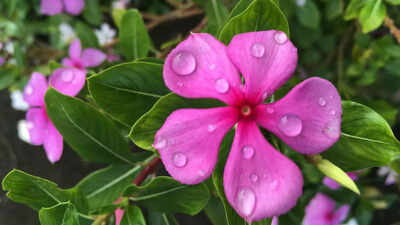ARTICLE AD BOX

The monsoon season is vital for groundwater replenishment and rejuvenation of plant vegetation; however, it presents some significant challenges for household and kitchen gardens, terrace agriculture, and indoor plants.
During the monsoon season, excessive moisture, shade, and erratic temperature changes can subject plants to immense physiological stress. The most common conditions observed in household gardening include fungal infection, root rot, nutrient deficiency, and sluggish, restrained, or stunted plant growth. In managing good plant health in this weather, homeopathy could act as a natural, toxin-free and soft yet effective method.
Understanding monsoon-induced plant stress
Sunlight is usually blocked for days during the season affecting the photosynthetic ability of the plants. Some plants that require 6-8 hours of sunlight, including herbs like basil and coriander, leafy greens like spinach, lettuce, succulents, and flowering plants, to name just a few, show signs of paling, which include yellowing leaves, elongated stems, and weakened structures.Excessive humidity intensifies the saturation of surrounding air, thus lowering evapotranspiration on plant surfaces and decreasing oxygen levels in the soil.
This leads to waterlogging and increased pathogenic fungi and bacteria, e.g., powdery mildew, damping-off disease, and black mold. The quietness of indoor air causes an increase in the proliferation of fungi in plants. It is also a common season for pest growth such as aphids, mealybugs, whiteflies, and fungus gnats, weakening plant immunity.
Homeopathic remedies for monsoon plant stress

Homeopathy, through its non-toxic, vibration-based drugs, can provide curative and prophylactic advantages to plants without suppressing the ecosystem.
Remedies are given in low potencies, either in the form of foliar spray or watering, to facilitate quick systemic uptake.A well-considered combination of homeopathic remedies can most effectively counter the stress plants undergo during monsoons. Silicea 6X or 30C is especially useful for plants that have weak stems, wilting leaves, or stunted growth in low-light, damp conditions, building structural strength when used weekly as a foliar spray or every 10 days through root watering.
For plants with water retention, root rots, or fungal infections caused by too much water, Natrum Sulphuricum 6X or 30C works through internal cleansing and balancing water and is advised use every 5 to 7 days.
Arsenicum Album 30C can be used to control fungal infestations caused by wet, stagnant conditions on plants with signs of mold, discoloration, or decreased vitality; it is used weekly as a preventative or bi-weekly as an active outbreak.
Calendula Officinalis 30C, with its natural antiseptic properties, promotes healing wounds caused by pruning or pest injury and may be used directly or in spray form. For hypoxic or waterlogged plants with heavy soil, Carbo Vegetabilis 30C restores life by enhancing root oxygenation when applied bi-weekly as a drench. Finally, Sulphur 30C is a general-purpose antifungal growth preventative, particularly beneficial for greens and flowering crops, and is best utilized as a light foliar spray every 10 days.
Together, these remedies provide a solid, non-toxic arsenal for coping with plant stress during the demanding monsoon months.
Conventional methods to supplement homeopathic assistance
Though homeopathy provides the basis of natural plant care throughout the monsoon, its potency is significantly augmented when supplemented by considerate horticultural practices. Keeping soil aeration in check through careful loosening of top potted soil prevents compaction by ensuring root supply of oxygen.
Effective drainage is just as important; standing pots or using gravel beneath them keeps water out, and not having water-collecting saucers under planters also guards against root rot.
Providing natural ventilation, either from open windows or occasional use of fans, suppresses indoor excess humidity and prevents fungal growth. The use of organic mulch like coco peat, dried neem leaves, or straw retards soil structure loss, alleviates rainfall splashback, and inhibits spore spread.
To control pests organically, weekly neem oil emulsion spray works well, better if accompanied by homeopathic treatment of Staphysagria 30C for aphids and Cina 30C for larvae. Lastly, strict watering only when the soil's top inch is dry is a must, as overwatering is one of the rainy season's most frequent causes of plant stress. Combined, these complementary practices provide a balanced, holistic setting that enhances the resilience and restoration of monsoon-hit plants.
Nurturing resilience
Moisture, limited sunlight, and an increase in microbial growth can take a heavy toll on the health of indoor plants, rooftop vegetables, and kitchen gardens during this time. However, by embracing a mindful, holistic care system based on homeopathic science and ancient plant knowledge, gardeners can build a resilient structure for their green spaces. Remedies such as Silicea, Natrum Sulphuricum, and Arsenicum Album not only cure symptoms but balance the plant's natural reactions to stress in its environment.
Combined with good gardening habits such as soil aeration, careful watering, and pest control, these subtle interventions stimulate healing and longevity. With considerate, nature-sensitive methods, city gardeners can not only enable their plants to survive the rains but also have them emerge as healthier, more resilient, and better attuned to nature's cycles.Attributed by Padma Shri Dr. Mukesh Batra, Founder-Chairman Emeritus, Dr Batra's Healthcare
'Mangrove man' in Kerala fights to salvage sinking shores



.png)
.png)
.png)
















 1 day ago
2
1 day ago
2









 English (US) ·
English (US) ·